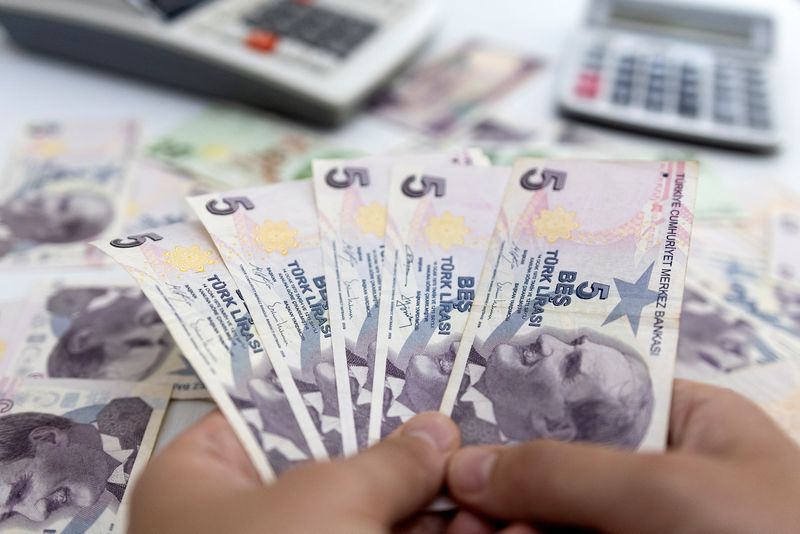 © Reuters. Woman holds Turkish Lira banknotes in this illustration taken May 30, 2022. REUTERS/Dado Ruvic/Illustration
© Reuters. Woman holds Turkish Lira banknotes in this illustration taken May 30, 2022. REUTERS/Dado Ruvic/Illustration
By Marc Jones
LONDON (Reuters) -Turkey's lira took a 7% nosedive on Wednesday as the country's newly re-elected government appeared to be abandoning its costly 18-month strategy of keeping the currency on a tight leash by any means necessary.
Ankara has seen decades of financial market difficulties and the charts below show the challenges the lira's weakness poses for the country's new economic decision makers.
1/LET IT GO?
A combination of a sizeable budget hole, an inflation problem and thanks to a couple of years of highly questionable policies, a puny pile of FX reserves, means that there are plenty of reasons for the lira to keep falling.
If, or where, it stops nobody really knows. Analysts at Wall Street giants like JPMorgan (NYSE:JPM) and Goldman Sachs (NYSE:GS) and FX forwards markets all think 25 or even 30 to the dollar might be possible, which is another big lurch down even from Tuesday's record low levels.
Much will depend on whether the central bank now jacks up interest rates in the big way it has done during other bouts of turmoil, or even introduces capital controls - something the authorities in Turkey have long insisted is not on the table.
The central bank is however widely expected to get a new head in the coming days. That would almost certainly be followed almost immediately by a super-sized hike, to somewhere in the region of 25%-30% from the current 8.5%, JPMorgan predicts.
Ulrich Leuchtmann, head of FX research at Commerzbank (ETR:CBKG) in Frankfurt added: "This is what happens when you get an exponential move - for a long time you think nothing happens, and then all of a sudden all hell breaks loose".
2/NO GAIN, NO PAIN
A potential sharp interest rate hike could easily grind the Turkish economy to a standstill again, or even worse tip it into recession, as consumers tighten their belts and companies watch borrowing costs explode.
Some of the pain could be offset by the weaker lira spurring exports potentially adding to boost of the upcoming tourism season and the reconstruction spending in the wake of February's devastating earthquake.
"GDP in local currency terms is more at risk from a course correction on interest rates, where rate hikes rein in rampant credit growth, rather than devaluation per se," said Hasnain Malik at Tellimer.
Turkey's economy is no stranger to boom-and-bust cycles, oscillating between double-digit growth and contraction rates in recent years. In its latest spring forecast, the International Monetary Fund projected a 2.7% expansion for 2023.
3/INFLATION PALPITATIONS
A tumbling lira will fan fears over a fresh spike in inflation in the country which only last year saw it top 80%.
Data on Monday showed headline inflation dipped to below 40% although that was partly down to Erdogan providing Turks with free natural gas in the run up to the elections.
Analysts were already expecting it to climb back towards 50% before the latest currency drop and Tellimer's Malik said it might now even snap back to the peak levels of last year as both the free gas ends and the FX moves work through the system.
"It's just so inevitable," Abrdn's head of local currency emerging market debt, Kieren Curtis, said referring to the lira's slump this week.
"There is just going to be more inflation so it's difficult to say what's going to turn that without a huge hike in interest rates."
4/ACCOUNTING PROBLEMS
One of the costs Turkey now faces is covering the special lira depreciation-protected bank accounts the government and central bank set up in late 2021 to convince Turks not to convert all their money into dollars or gold.
Frank Gill, a top sovereign debt analyst at credit rating agency S&P Global (NYSE:SPGI), estimates that if the lira drops to around 26.5 per dollar - 20% lower than where it was after President Tayyip Erdogan's re-election on Sunday - the compensation cost would be just under 3% of GDP.
He did add however that the compensation would be paid to depositors in lira rather than dollars or euros and that bill would be split between the Treasury and Central Bank.
5/DEBT DILEMMA
The other big problem is that $100 billion worth debt borrowed by Turkey's governments, companies and households is in dollars or euros - loans which are now getting ever more expensive to service unless you're a company whose goods are also sold in dollars anyway.
If the debt can't be repaid, the banks that gave the loans have a problem too as their balance sheets will start sprouting holes unless they have hedged themselves accordingly.
It could have wider ramifications too. Fund managers at NinetyOne estimate that when default-threatened CCC-rated countries are excluded, Turkey accounts for approximately 60% of all "high yield" emerging market sovereign debt payments due for each of the next four years.

